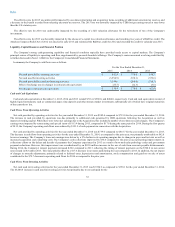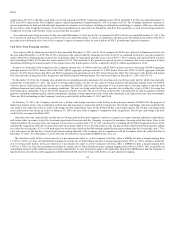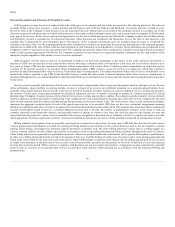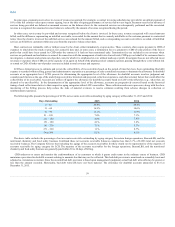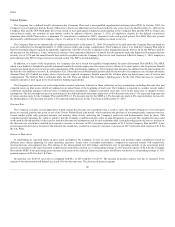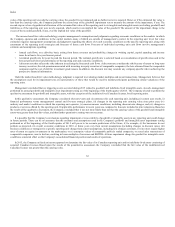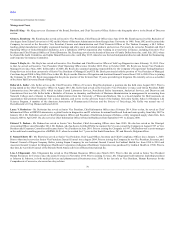LabCorp 2015 Annual Report Download - page 63
Download and view the complete annual report
Please find page 63 of the 2015 LabCorp annual report below. You can navigate through the pages in the report by either clicking on the pages listed below, or by using the keyword search tool below to find specific information within the annual report.
Index
The Company has made in this report forward-looking statements concerning the Company’s operations, performance and financial condition, as well as
its strategic objectives. Some of these forward-looking statements can be identified by the use of forward-looking words such as “believes”, “expects”,
“may”, “will”, “should”, “seeks”, “approximately”, “intends”, “plans”, “estimates”, or “anticipates” or the negative of those words or other comparable
terminology. Such forward-looking statements are subject to various risks and uncertainties and the Company claims the protection afforded by the safe
harbor for forward-looking statements contained in the Private Securities Litigation Reform Act of 1995. Actual results could differ materially from those
currently anticipated due to a number of factors in addition to those discussed elsewhere herein, including in Item 1A Risk Factors, and in the Company’s
other public filings:
1. changes in U.S., state, local and third party payer regulations or policies or other future reforms in the healthcare system (or in the interpretation of
current regulations), new insurance or payment systems, including state, regional or private insurance cooperatives (e.g., Health Insurance
Exchanges), affecting governmental and third-party coverage or reimbursement for clinical laboratory testing;
2. significant monetary damages, fines, penalties, assessments, refunds, repayments, and/or exclusion from the Medicare and Medicaid programs,
among other adverse consequences, resulting from interpretations of, or future changes in, laws and regulations, including laws and regulations of
Medicare, Medicaid, the U.S. False Claims Act, interpretations of such laws and regulations by U.S. or state government agencies or investigations,
audits, regulatory examinations, information requests and other inquiries by state or U.S. government agencies;
3. significant fines, penalties, costs and/or damage to the Company’s reputation arising from the failure to comply with U.S. and international privacy
and security laws and regulations, including the Health Insurance Portability and Accountability Act of 1996, Health Information Technology for
Economic and Clinical Health Act, U.S. state laws and regulations, and laws and regulations of the European Union and other countries;
4. loss or suspension of a license or imposition of a fine or penalties under, or future changes in, or interpretations of, the law or regulations of the
Clinical Laboratory Improvement Act of 1967, and the Clinical Laboratory Improvement Amendments of 1988;
5. penalties or loss of license arising from the failure to comply with the U.S. Occupational Safety and Health Administration requirements and the U.S.
Needlestick Safety and Prevention Act, or similar laws and regulations of U.S., state, local or international agencies;
6. fines, unanticipated compliance expenditures, suspension of manufacturing, enforcement actions, injunctions, or criminal prosecution arising from
failure to maintain compliance with current good manufacturing practice (cGMP) regulations and other applicable requirements of various
regulatory agencies;
7. sanctions or other remedies, including fines, unanticipated compliance expenditures, enforcement actions, injunctions or criminal prosecution
arising from failure to comply with the Animal Welfare Act;
8. changes in testing guidelines or recommendations by government agencies, medical specialty societies and other authoritative bodies affecting the
utilization of laboratory tests;
9. changes in government regulations or policies, including regulations and policies of the FDA, the U.S. Department of Agriculture or other U.S., state,
local or international agencies, affecting the approval, availability of, and the selling and marketing of diagnostic tests or drugs or the conduct of
drug development trials;
10. changes in government regulations pertaining to the pharmaceutical and biotechnology industries, changes in reimbursement of pharmaceutical
products or reduced spending on R&D by pharmaceutical and biotechnology customers;
11. liabilities that result from the inability to comply with corporate governance requirements;
12. increased competition, including price competition, competitive bidding and/or changes or reductions to fee schedules and competition from
companies that do not comply with existing laws or regulations or otherwise disregard compliance standards in the industry;
13. changes in payer mix, including an increase in capitated reimbursement mechanisms or the impact of a shift to consumer-driven health plans and
adverse changes in payer reimbursement or payer coverage policies related to specific testing procedures or categories of testing;
14. failure to retain or attract MCO business as a result of changes in business models, including new risk based or network approaches, or other changes
in strategy or business models by MCOs;
63


